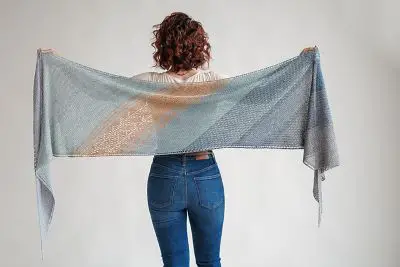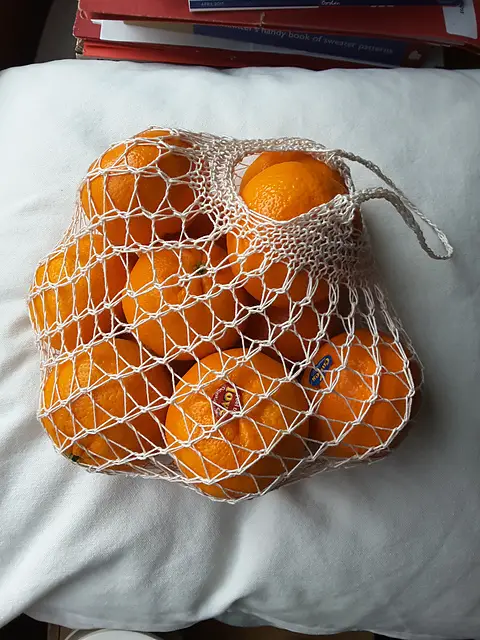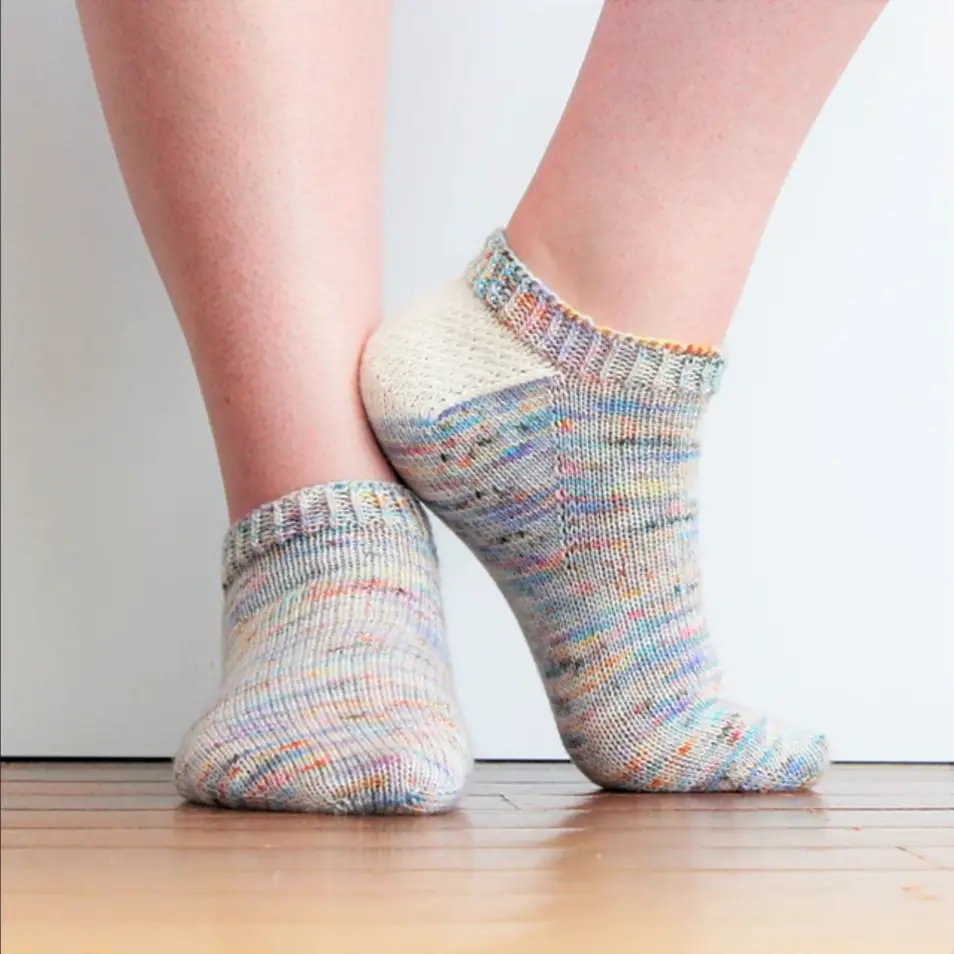Have you ever heard the term “fingering weight” yarn and wondered what it meant? I always thought that was an odd term. I recently found out the word “fingering” is actually derived from the French word fingram, meaning “fine grain.” When the word is used for yarn, it implies a thin strand. Probably why the yarn weight category has been dubbed “fine weight.”
Super Fine weight yarn is also called fingering or sock yarn. Both refer to a thin strand of yarn, the smallest thickness next to lace weight yarn. The fabric is composed of tiny stitches and results in a thin, lightweight material. Many garments, socks and accessories are popular projects.
I know how difficult it can be to choose yarn when you are starting out. You just want to buy any skein that looks appealing and feels soft. But the yarn weight matters when you want a certain look to your project. Look at the photos for instance. The items would not be lightweight if a heavier weight yarn were used though. If you want to snag the free patterns, click the links: Find Your Path Shawl by Jane Vaneslous, Weightless Produce Bag by Julie Tarsha, and Day Off Socks by Jessica Gore.
In my previous article we learned about Lace Weight Yarn. In this one, I want to cover the next weight and what the industry means by “super fine” yarn. I invite you to come along and learn with me!
Super Fine Weight Yarn Standards
The Craft Yarn Council (CYC) created a standard yarn weight system for the US. It is based on a number system that starts from 0, the thinnest, and goes up to 7, the thickest. Super fine weight yarn is what the CYC considers a 1. Besides the numbering system, the CYC also gives guidelines for gauge and hook/needle sizes for super fine weight yarn.
CYC Gauge and Tool Recommendations
Gauge, hook and needle suggestions for knit and crochet are printed on the labels. These are based on the testing done by the yarn manufacturers.
But the CYC put a set of guidelines for everyone (in the US) to use, which is listed below. The information is based off of the CYC website and you can access that here for more details.
| | Standard CYC Gauge* | CYC Recommended Tool Size |
| Knit | 27 – 32 sts stockinette | 2.25 – 3.25mm, 1 – 3(US) needles |
| Crochet | 21 – 32 sts sc | 2.25 – 3.5mm, B-1 – E-4(US) hook |
Ravelry (an online database for crochet and knitting patterns) also provides a guideline for knit gauge. According to them, you should get 28 stitches per 4 inches (10 cm). You can see that this is in align with what the CYC says.
Remember though, these are not exact. The gauge and hook/needle size provide you with a strong baseline, but you should always do your own testing.
Wraps Per Inch
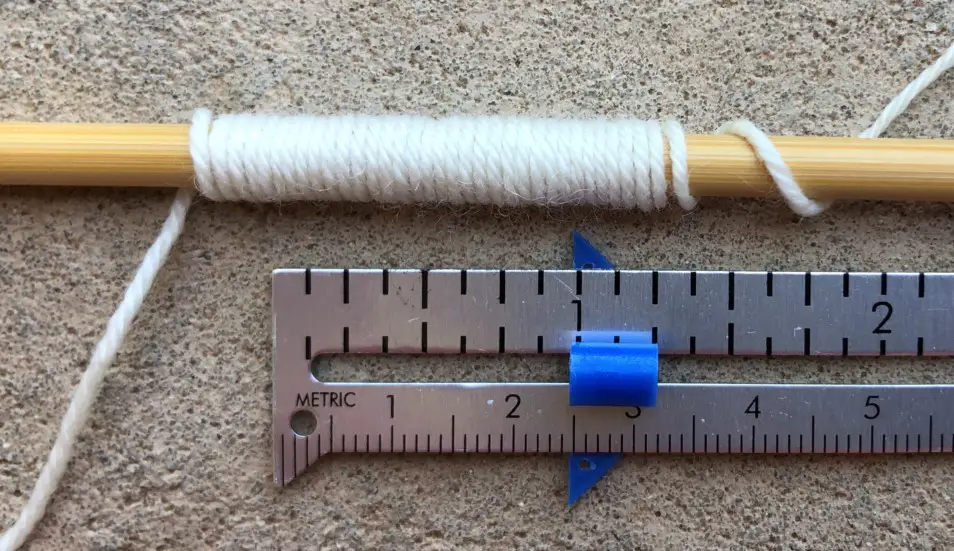
Wraps per inch (WPI) is useful for yarn weights if you ever lose your labels. Measuring WPI is super simple. The CYC has more detailed information on their website here. But basically you wrap yarn around a pencil. Then you measure an inch and count how many wraps are in that inch. Finally, you compare to the CYC standards for WPI to know what the yarn weight is.
The CYC states that super fine weight (1) should have 14-30 wraps per inch. Bluprint says that super fine weight yarn is 19-22 WPI, which is a smaller margin, but still in alignment with the CYC. You can access the Bluprint article here. Ravelry states that super fine weight yarn should be 14 WPI according to their yarn weight standards page.
The yarn I had on hand was Dyer Supplier Merino Cashmere Nylon Sock Yarn. I got 23 wraps per inch for this sock yarn. It is definitely within the super fine weight category according to the CYC yarn weight standards.
Other Common Terms for Super Fine Weight Yarn
As I mentioned previously, the CYC created the yarn weight system for the US. Super fine weight is equivalent to a 1 according to their standards. But not everyone in the world uses the same terminology. I summarized the most common terms used for super fine weight yarn below, and I will go into more detail about each.
Also Known As
- Super Fine – 1
- Sock
- Fingering
- Baby
- 2-ply
- 3-ply
- 4-ply
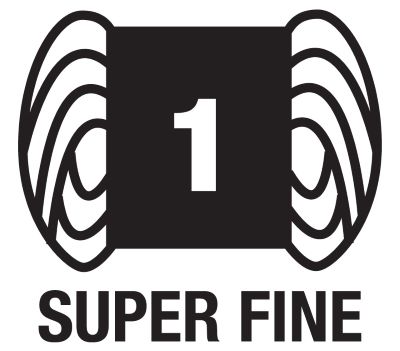
In the US, and other countries, super fine weight yarn is also commonly called sock, fingering and baby yarn. Often, these terms are used interchangeably, but there can actually be differences in the yarn to be aware of.
- Super Fine – 1. This is how the Craft Yarn Council refers to the thin yarn. The symbol above is what is printed on yarn labels in the US so that you can easily identify the yarn weight.
- Sock yarn. As the name implies, socks are generally made from sock yarn. To ensure socks won’t wear down easily, the fibers are often blended with nylon. This strengthens the fabric so that it is durable and won’t pill. The stitches have a structured and uniform look.
- Fingering yarn. Fingering yarn is similar to sock yarn, but the fibers are not usually blended with nylon. The thickness can also be smaller than sock yarn. Fingering yarn is better for creating lace because the fibers relax easier and create a nice drape. They also remain in place, whereas lace made from sock yarn may need to be blocked several times to open up the lace.
- Baby yarn. To me, this is a broad term because there are baby yarns in other yarn weights, not just for super fine. With that being said, super fine is a popular yarn weight to make lightweight baby garments and accessories. Maybe that is the reason for the term “baby yarn.”
The UK, Australia and New Zealand tend to refer to yarn weights by plies. The lower the ply count, the thinner the yarn. Although, don’t confuse this with how many plies the yarn is actually composed of. Ply count used to refer to the number of strands in the yarn, but modern processes have changed that. Now the term ply simply means the thickness of the yarn, when referring to yarn weights.
I looked at several sources to hopefully give the most accurate information, as I live in the US and don’t use this notation for yarn weights. This is what I found.
- 2-ply. 2-ply is the UK term for fingering/sock weight yarn.
- 3-ply. I found sources that say New Zealand and Australia refer to fingering and sock yarn as 3-ply.
- 4-ply. Ravelry lists 4-ply as the UK, NZ and AU term for super fine weight yarn. I found only one other source that listed 4-ply as a term used in New Zealand.
If you live in one of the areas that uses ply to determine yarn weight, please let me know if I should update this section!
Important Properties of Super Fine Weight Yarn

Super fine weight yarn has several important properties that affect every purchaser of yarn. First there is fiber content. It is important to know what fibers the yarn is made from so you know how to treat it for your projects. Next, the yardage is important because that affects the project size. Finally, the price of the yarn is an important property that affects whether or nor you buy it.
Throughout these next sections, I dive deeper into each property of super fine weight yarn. In order to do so, I conducted my own research. I looked at five major yarn companies so I could understand more about industry behaviors regarding yarn weights. I hope you find it interesting!
Common Fiber Content
I like to break fiber content into three categories: natural fibers, synthetic fibers, and blends of natural and synthetic fibers. According to my research, 23% of super fine weight yarn is made from natural fibers and 17% is made from synthetic fibers. The other 60% is a blend of natural and synthetic fibers.
This makes sense because a good majority of super fine weight yarn is used for socks, so nylon is blended with wool fibers (typically). The nylon makes the natural fiber stronger, thus making it more durable for longer wearing socks.
I have summarized the common fibers below. I didn’t add the blends though because that can vary. As a general rule though, nylon or polyester is usually blended with a type of wool.
Natural Fibers
- Cotton
- Merino
- Mohair
- Wool
- Silk
- Superwash Merino
- Cashmere
- Bamboo
- Alpaca
Synthetic Fibers
- Nylon
- Acrylic
- Polyester
- Polyamide
- Stellina
- Rayon
Yardage Estimation
When it comes to yardage, unfortunately there is no set standard for the amount of yards per ounce/gram. That is up to the yarn manufacturer. But I was curious, just as I am sure you are, how many yards I can expect on average for super fine weight yarn. This is super important when planning for a pattern.
As I stated before, I looked at 5 major yarn companies in the US. The following is based on my findings. For super fine weight yarn, you can expect 459 yards per skein on average. The lowest amount of yardage I came across was 152 yards and the highest was 4200 yards.
Average Price
Price is also an important aspect to keep in mind when you are choosing and comparing yarn. I found that you can expect to pay on average $10.21 per skein of super fine weight yarn. Of course, that also means you could pay much more or much less depending on where you shop.
Where to Find Super Fine Weight Yarn
Super fine weight yarn can be found in many places. Most chain craft stores do not carry fingering/sock weight yarn in stores. All I have seen is the Patons brand sock yarn in limited colors in my area.
If you have a locally owned yarn shop in your area, you would have a much bigger selection of super fine weight yarn to choose from. I, however, don’t have that luxury, but wish I did.
Finally, you can always buy super fine weight yarn online. There are many yarn retailers that have fingering and sock weight yarns for sale. The only drawbacks are that you must wait for its arrival (so hard!) and you can’t feel the yarn before purchasing.
Types of Projects Best for Super Fine Weight Yarn
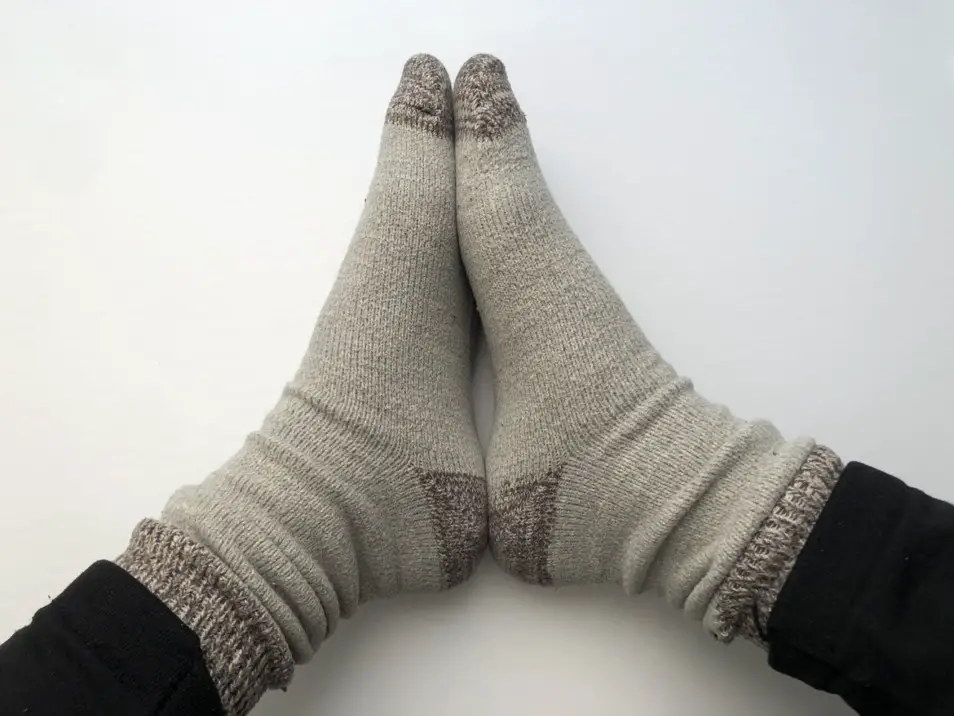
Super fine weight yarn will produce a fabric made up of tiny stitches that can resemble a store-bought look. It will also be thin and lightweight, with a lot of drape.
Compared to lace weight yarn, fingering/sock yarn will be easier to work with, but projects will still take awhile to complete. The end result is completely worth it though!
Ravelry has a total of 127,741 patterns (at the time of this post) that uses fingering weight yarn. And over 41,779 of those are free! You will no doubt find a project that you like.
Popular items to knit or crochet with super fine weight yarn include garments, shawls and lace. I compiled a list of all the project types that I could think of that pair well with lace weight yarn. You are by no means limited to only these projects, but I hope these spark inspiration!
Garments
- Socks
- Shawls
- Cardigans
- Sweaters
- Baby Clothes
Home
- Coasters
- Blankets (usually baby size)
- Dishcloths
- Grocery or Market Bag
- Amigurumi Stuffed Animals
Accessories
- Headbands
- Scrunchies
- Scarves
- Gloves
- Hats
- Cowls
- Jewelry
Super Fine Weight Yarn Recommendations + Tips
Fingering weight yarn is very popular amongst the knitting and crochet community. I personally have not used it much, so I don’t have the best recommendation right now. But I did recently buy a few skeins from Dyer Supplier to try out dyeing yarn for my own socks. I’ll report back when I have completed that task!
Tips:
- Use fingering weight yarn to create the most beautiful lacework. The thin strands knitted or crocheted together will open up beautifully after a little blocking. Whether you make an entire garment with lace stitches or use it on the edges, your final piece will look stunning.
- Fingering weight yarn is suggested to create cables. The cables will add texture (without bulk) to an otherwise bland, lightweight fabric.
- If you want to try your hand at a fair isle sweater, use fingering weight yarn. Most fair isle sweaters are made from super fine weight yarn. The colorwork looks incredible but doesn’t add a lot of bulk.
- Strand a super fine weight yarn with a worsted weight yarn. By doing this, you add a new texture and color (or possibly sparkles?).
Up Next
That concludes Super Fine Weight yarn (1). The next post covers Fine Weight yarn (2), which is the next size up of yarn. You can find it here.
The pictures listed at the top of the post are available in pattern form free through Ravelry. I do not claim these photos as my own, they are merely for illustration purposes. Click the links here to learn more about the patterns: Jane Vanselous, happybunkygirl, Jessica Gore.

